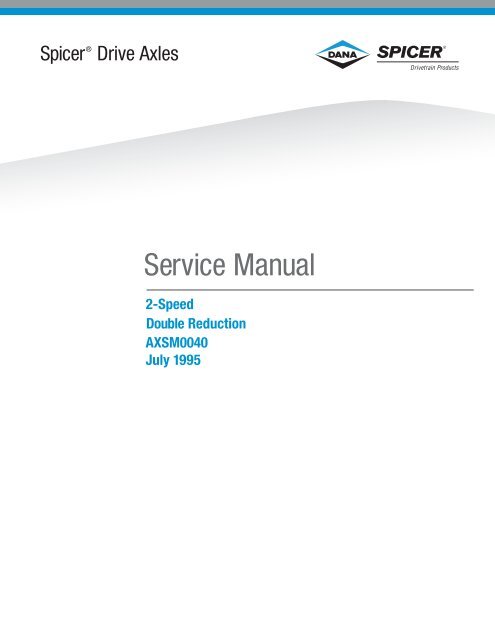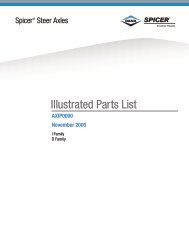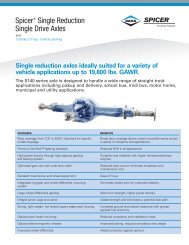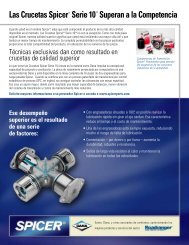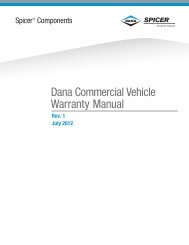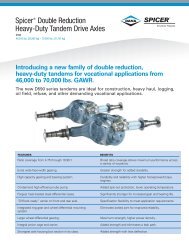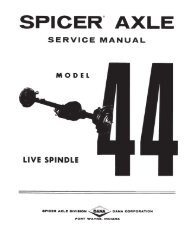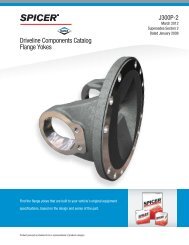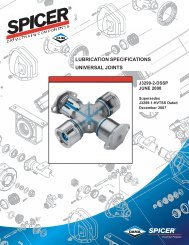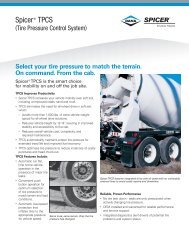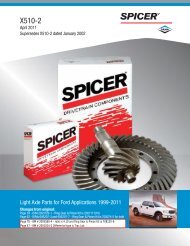Eaton Axle and Brake Service Manual. 2-Speed and Double ...
Eaton Axle and Brake Service Manual. 2-Speed and Double ...
Eaton Axle and Brake Service Manual. 2-Speed and Double ...
Create successful ePaper yourself
Turn your PDF publications into a flip-book with our unique Google optimized e-Paper software.
Spicer ® Drive <strong>Axle</strong>s<strong>Service</strong> <strong>Manual</strong>2-<strong>Speed</strong><strong>Double</strong> ReductionAXSM0040July 1995
The description, testing procedures, <strong>and</strong>specifications contained in this servicepublication were current at the time of printing.Dana reserves the right to discontinue ormodify its models <strong>and</strong>/or procedures <strong>and</strong> tochange specifications at any time withoutnotice <strong>and</strong> without incurring obligation.The recommendations of the vehiclemanufacturer should be considered as theprimary source of service information regardingthis Spicer product. This manual is intended tobe used as a supplement to such information.Any reference to br<strong>and</strong> names in thispublication is made simply as an example ofthe types of tools <strong>and</strong> materials recommendedfor use <strong>and</strong>, as such, should not be consideredas an endorsement. Equivalents, if available,may be used.Always use genuine Spicer replacement parts.2Price $3.50
PARTS IDENTIFICATION/NOMENCLATUREGeneralInformationThe service procedures <strong>and</strong> specifications in this publication cover the Spicer <strong>Axle</strong>slisted in the charts below.For Spicer <strong>Brake</strong> service information, refer to BRSM-O033 <strong>Service</strong> <strong>Manual</strong>.For shift system service information refer to Spicer Shift System <strong>Manual</strong> AXSM-0029For Parts identification, refer to your appropriate Spicer parts manual, referenceSpicer product literature order form TCFM-0018 for listings.Early <strong>Axle</strong> Series<strong>Axle</strong><strong>Axle</strong> Model Nos.Series 2-<strong>Speed</strong> <strong>Double</strong> Reduction15 15201 1530116 16244 1634417 17201, 17221 17301, 1732118 18201, 18221 18301, 1832121 21221 2132122 22221, 22223 2232123 23221 2332126 26221 2632130 30227 3032735 -35327NOTE: Throughout the manual, axle series identificationis used to indicate variances between axles.2-<strong>Speed</strong>15040T19050T19055T19060T21060T21065T22060T22065T23070T23080T23085T26080T26085TLate <strong>Axle</strong> Models<strong>Axle</strong> Model Nos.<strong>Double</strong> Reduction15040P19050P19055P19060P21060P21065P22060P22065P23070P23080P23085P26080P26085P30055P35055P<strong>Axle</strong> Identification<strong>Axle</strong> <strong>and</strong> differential carrier identification iseither stamped on the carrier itself or on ametal tag affixed to the carrier. Location onthe carrier is the same.OLD STYLE TAG<strong>Axle</strong> Specification NumberThe complete axle is identified by thespecification number stamped on the rearright-h<strong>and</strong> side of the axle housing. Thisnumber identifies all component parts of theaxle as built by Spicer, including specialOEM requirements such as yoke or flange.In addition, some axles may include a metalidentification tag (see illustration).This tag only identifies the housing. It does notidentify the differential carrier assembly components.METALIDENTIFICATIONTAG4
GeneralInformationPARTS lDENTIFICATION/NOMENCLATURERing Gear <strong>and</strong> Pinion IdentificationRing Gear <strong>and</strong> Drive Pinion are matchedparts <strong>and</strong> must be replaced in sets.Check the appropriate Spicer <strong>Axle</strong> partsbook for part numbers <strong>and</strong> orderinginstructions.To aid in identifying gear sets, both partsare stamped with such information asnumber of pinion <strong>and</strong> ring gear teeth,individual part number <strong>and</strong> matched setnumber (refer to drawing).SpicerINDICATES GENUINESPICER PARTS5
MAINTENANCE / ADJUSTMENTPeriodic<strong>Service</strong>LubricationThe ability of a drive axle to deliverquiet, trouble-free operation over aperiod of years is largely dependentupon the use of good quality gearlubricant in correct quantity. TheApproved Lubricantsmost satisfactory results can beobtained by following the dirrecommendationsfromections contained in this book.The following lubrication instructionsrepresent the most currentDana.Section 2Approved Lubricants - General:Gear lubricants acceptable undermilitary specification (MILSPEC)MIL-L-2105D (Lubricating Oils,Gear, Multipurpose) are approvedfor use in Spicer Drive <strong>Axle</strong>s.The MIL-L-2105D specificationdefines performance <strong>and</strong> viscosityrequirements for multigrade oils.It supersedes both MIL-L-2105B,MIL-L-2105C <strong>and</strong> cold weatherspecification MIL-L-10324A. Thisspecification applies to bothpetroleum-based <strong>and</strong> syntheticbasedgear lubricants if theyappear on the most current"Qualified Products List "(QPL-2105) for MIL-L-2105D.NOTE: The use of separate oiladditives <strong>and</strong>/or friction modifiersare not approved for use in SpicerDrive <strong>Axle</strong>s.Approved Lubricants - Syntheticbased: Synthetic-based gearlubricants exhibit superior thermal<strong>and</strong> oxidation stability, <strong>and</strong>generally degrade at a lower ratewhen compared to petroleumbasedlubricants. The performancecharacteristics of these lubricantsinclude extended change intervals,improved fuel economy, betterextreme temperature operation,reduced wear <strong>and</strong> cleanercomponent appearance. The familyof Spicer gear lubricants representsa premium quality synthetic lubewhich fully meets or exceeds therequirements of MIL-L-2105D. Theseproducts, available in both 75W-90<strong>and</strong> 80W-140, have demonstratedsuperior performance in comparisonto others qualified underthe MILSPEC, as demonstrated byextensive laboratory <strong>and</strong> fieldtesting.Lube Sampling <strong>and</strong> ConditionMonitoring: For information,contact your local Dana representationat phone numbers listed onthe back cover of this manual.Makeup Lube: Maximum amount ofnon-synthetic makeup lube is 100%.Viscosity/Ambient TemperatureRecommendations: The followingchart lists the various SAE Gradescovered by MIL-2105D <strong>and</strong> theassociated ambient temperaturerange for each. Those SAE Gradesshown with an asterisk (*) areavailable in the Spicer family ofsynthetic gear lubricants.The lowest ambient temperaturescovered by this chart are -40 o F <strong>and</strong>-40 o C. Lubrication recommendationsfor those applications whichconsistently operate below thistemperature range, must beobtained through the Dana.GradeAmbient Temperature Range75W -40 o F to -15 o F (-40 o C to -26 o C)75W-80 -40 o F to 80 o F (-40 o C to 21 o C)75 W-90* -40 o F to 100 o F (-40 o C to 38 o C)75 W-140 -40 o F <strong>and</strong> above (-40 o C <strong>and</strong> above)80W-90 -15 o F to 100 o F (-26 o C to 38 o C)80W-140*-15 o F <strong>and</strong> above (-26 o C <strong>and</strong> above)85 W-140 10 o F <strong>and</strong> above (-12 o C <strong>and</strong> above)6
Periodic<strong>Service</strong>MAINTENANCE / ADJUSTMENTLube Change IntervalsLubrication Change Internals -General: The initial lubricantchange is one of the mostimportant factors in axle componentlife <strong>and</strong> durability, becauseof the elimination of break-incontaminants. These contaminantsare primarily iron from the initialbreak-in wear of rotatingcomponents, <strong>and</strong> silicon from thes<strong>and</strong> used in manufacture of castcomponents.For either a new or rebuilt driveaxle, the lubricant should bechanged within the first 3000 to5000 miles of operation. Subsequentlubricant changes should bebased on a combination of theintervals stated in the followingchart <strong>and</strong> user judgment basedheavily on the application <strong>and</strong>operating environment.Changing LubeDRAINING: Drain into suitable containerwith lube at normal operating temperature.Inspect drain plug for excessive metalparticle accumulation symptomatic ofextreme wear. Clean <strong>and</strong> replace plug afterdraining.Lubrication Change Intervals - NOTE: At both the initial <strong>and</strong> allSevere <strong>Service</strong>: Severe service subsequent lubricant changes,applications are those whichSpicer recommends that therequire the axle to be consistently magnetic filler <strong>and</strong> drain plugs,operated near it•s maximum GCW <strong>and</strong> the breather be cleaned.or GVW ratings, dusty or wetenvironments, or consistent operationon grades greater than 8%.For these applications, the ON/OFFHIGHWAY portion of the chartshould be used.Guidelines - Lube Change Intervals for Drive <strong>Axle</strong>sMaximum On/Off Highway MaximumLubricant On Highway Change Severe <strong>Service</strong> ChangeType Miles Interval Miles Interval, r 1 1 IMineral100,000 Yearly 40,000 YearlyBasedSpicerApproved 250,000 3 Year 100 ,000 YearlySynthetlcNOTE: After initial lube change, the entireunit should be inspected if excessiveparticle accumulation is observed.FILLING: Remove filler hole plug <strong>and</strong> fillhousing- - -with approved lubricant until levelwith bottom of filler hole.ISection 2Late <strong>Axle</strong> Model15040T/P . . . . . . . . . . . . . . .19050T/P . . . . . . . . . . . . . . .19055T/P, 19060T/P . . . . . .21060T/P, 21065T/P,22060T/P, 22065 T/P . . .23070T/P . . . . . . . . . . . . . . .23080T/P . . . . . . . . . . . . . . .Lube Capacities DO NOT OVERFILL AXLESPints24.033353539.041(Liters)(17.3)(15.6)(16.6)(16.6)(18.4)(19.0)41 (19.0)41 (19.0)36 (17.0)36 (17.0)NOTE: Capacities do not apply to housings not designed by SpicerEarly Spicer Housing Vendor Housing<strong>Axle</strong>(Round Arm)Series Pints (liter)23 (11) 19 ( 9)33 24 (11)37 (18) 29 (14)37 (18) - -41 (19) 34 (16)41 (19)- -<strong>Axle</strong>s installed at angles exceeding 6 o or operated regularly on grades exceeding may require st<strong>and</strong>-pipes to allowproper fill levels. For specific information, contact your Dana representative at phone numbers listed on back cover ofthis manual.7
MAINTENANCE / ADJUSTMENTPeriodic<strong>Service</strong>Wheel End LubricationIMPORTANT: In cases where wheelequipment is being installed, either new orafter maintenance activity, the lube cavitiesare empty. Bearings <strong>and</strong> seals must bemanually supplied with adequate lubricantor they will be severely damaged before thenormal motion of the vehicle can supplylube to the hub ends of the housing.To avoid the risk of premature damage towheel bearings <strong>and</strong> seals, they must be"prelubed" any time the wheel equipment isbeing installed. There are two methods ofdoing this. The correct method will dependon the type of wheel equipment being used.Section 2Lubrication When Hubs Have No Filler Holes (Preferred Method*)(Follow procedure in numerical sequence.)3. Jack up right side ofaxle. Maintain this position1. Fill axle with lube through axle housing cover filler hole. for one minute to allow2. Jack up left side of axle.Maintain this position for \one miflow inright silube to flow into wheelends at left side.4. With vehicle level a~ain, add lubethrough axle housing cover filler hole. Theaxle should require two additional pints oflube to bring level up to bottom of filler hole.*The above procedure is the preferred method since it optimizes the lube supply to thewheel end components <strong>and</strong> axle sump.Hubs Equipped with Lube Filler HolesPour a pint of st<strong>and</strong>ard axle lubricant intothe hub through the cavity filler holeprovided.8
Periodic<strong>Service</strong>MAINTENANCE / ADJUSTMENTWheel Bearing AdjustmentWheel bearings should be adjusted atregular intervals using the followingprocedure:PREPARATION: Provide means to capturelubricant that will escape when axle shaftsare removed. Remove axle shafts. Jack thewheel to be adjusted clear of the ground.After securely blocking the vehicle to preventrolling, release the parking brake, allowingthe wheel to rotate freely.1. Remove outer adjusting nut <strong>and</strong> doweled(or tanged) washer.2. Visually inspect spindle for damage orwear. Inspect the nut <strong>and</strong> spindle threads fordamage. Make certain that the nut turnswithout binding by cleaning the threads <strong>and</strong>applying a light coat of oil prior to adjustingthe wheel bearings. Inspect tanged washer(if used). Replace washer if tangs are brokenor badly misshaped.3. Torque inner nut to 200 lbs.-ft.(272 N.m)while rotating the wheel. Loosen the nutone full turn. - Re-torque to 50 Ibs.-ft.(68 N.m). Back off nut 1/4 of a full turn.4. Install doweled (or tanged) washer. If thedowel pin <strong>and</strong> washer (or washer tang <strong>and</strong>nut flat) are not aligned, remove washer, turnit over <strong>and</strong> reinstall. For further alignment,loosen the inner nut slightly.5. install outer nut <strong>and</strong> torque as follows:l Doweled washer type lock - 300 Ibs.-ft.(408 N.m)l Tanged washer type lock - 250 Ibs.-ft.(339 N.m)WARNING: Never work under avehicle supported only by a jack.Insure that the vehicle will not rollbefore releasing brakes.TANGED WASHER TYPEThis adjustment procedure should allowwheel to turn freely within .001" to .005" 6. If using the tanged washer type lock,(0.025 to 0.125 mm) end-play. secure adjusting nuts by bending one wheelNOTE: The end-play should be measured nut washer tang over each nut. Bend tangsusing a dial indicator. If the tires <strong>and</strong> wheels over the closest flat perpendicular to the tangare on the hub, prying the wheel end before (see illustration).making the end-play measurement will 7. Reinstall axle shaft. Refill axle to properproduce a more accurate reading.lube level.Section 29
MAINTENANCE / ADJUSTMENTPeriodic<strong>Service</strong>CleaningProper cleaning requires completedisassembly.The differential carrier assembly may besteam cleaned only while mounted inhousing provided all openings are plugged.Wash steel parts with machined surfaces ina commercial solvent.Wash castings or other rough parts insolvent or clean in hot solution tanks usingmild alkali solutions, heating partsthoroughly before rinsing.WARNING: Gasoline is not anacceptable cleaning solvent becauseof its extreme combustibility. It isunsafe in the workshop environment.Rinse all parts thoroughly. Dry immediatelywith clean rags. Lightly oil parts <strong>and</strong> wrapin corrosion-resistant paper if not reusedimmediately. Store parts in a clean,dry place.Section 2InspectionAll axle components should be closelyinspected after cleaning to determinewhich require replacement. For moredetailed inspection guidelines <strong>and</strong> failureanalysis, see Spicer Failure Analysis<strong>Service</strong> <strong>Manual</strong> AXSM-0020In General:Inspect steel parts for notches, visible stepsor grooves. Look for scuffing, deformationor discoloration related to improperlubrication.Inspect gear teeth for signs of excessivewear, pitting or cracking along contactlines before reusing. Check tooth contactpattern.Inspect machined surfaces of cast ormalleable parts for cracks, scoring, <strong>and</strong>wear. Look for elongation of drilled holes,wear on machined surfaces <strong>and</strong> nicks orburrs in mating surfaces.Inspect fasteners for rounded heads, bends,cracks or damaged threads.The axle housing should be inspected forcracks or leaks, loose studs or crossthreadedholes.A CAUTION: Any damage which affectsthe alignment or structural integrity of thehousing requires housing replacement.Repair by welding or straightening shouldnot be attempted. This process can affectthe housing metallurgy <strong>and</strong> cause it to failcompletely when under load.Repair <strong>and</strong> ReplacementReplace lower-cost parts, such as thrustwashers, seals, etc., that protect the axlefrom premature wear <strong>and</strong> do not addgreatly to the cost of your rebuild.Replace heavily worn but unbroken parts,since the damage done, should they fail,would greatly exceed their replacement cost.Steel parts such as shafts or gears are notrepairable. If worn or damaged, they shouldbe replaced, along with mating parts asnecessary.Seals <strong>and</strong> washers should be routinelyreplaced. Fasteners with self-lockingpatches may be reused if secured withseveral drops of Loctite #277.<strong>Axle</strong> housing repairs are limited to removalof nicks or burrs on machined surfaces orreplacement of damaged studs.10
Drive <strong>Axle</strong>OverhaulREMOVAL / DISASSEMBLYDifferential Carrier Assembly Removal(Follow procedure in numerical sequence.)5. 2-<strong>Speed</strong> <strong>Axle</strong> Only - Disconnect shiftunit air lines or electrical wires.Remove shift units.NOTE: When shift unit or axle shaft isremoved, provide container to catch4. Remove axle shafts, stud nuts, lockwashers \ oil that escapes from reservoir.<strong>and</strong> taper dowels (if used). If necessary, \loosen dowels by holding a brass drift in6. Remove nuts, cap screws <strong>and</strong> washersthe center of the shaft head <strong>and</strong> striking itfastening carrier to axle housing. Removea sharp blow with a hammer.differential carrier assembly.WARNING: Do not strike the axleshaft flange with a hammer. Do notuse chisels or wedges to loosenshaft or dowels.WARNING: Do not lie under carrierwhile removing fasteners or afterfasteners are removed. Use transmissionjack to support <strong>and</strong> removedifferential carrier assembly.NOTE: If replacing carrier assembly as a unit, turn to Assembly Section 3, page 31, for instructions.Disassemble Differential CarrierNOTE: If gear set is to be reused, checktooth contact pattern <strong>and</strong> ring gearbacklash before disassembling differentialcarrier. Best results are obtained whenestablished wear patterns are maintained inused gearing. Omit this step if the gear setis to be replaced.1. Mount differential carrier assembly inrepair st<strong>and</strong>. Loosen but do not removepinion nut..Section 311
REMOVAL / DISASSEMBLYDrive <strong>Axle</strong>OverhaulDisassemble Differential Carrier (cont'd)2. Remove shift fork seal <strong>and</strong> spring.Remove expansion plugs, then working atthe lower (or small) plug hole, drive out theshift fork shaft.WARNING: When using a drift, punchor similar tool, wear safety glasses.3. 2-<strong>Speed</strong> <strong>Axle</strong>s Only: Remove slidinggear. To remove sun gear, remove theretainer which holds gear in position, thenremove sun gear.Section 3NOTE: When reusing gear set, punchmark bearing adjusters <strong>and</strong> bearing capsfor location <strong>and</strong> easier adjustment duringreassembly.4. On teeth-side of ring gear, cut lockwire<strong>and</strong> remove bearing cap screws. Removecap, adjuster <strong>and</strong> lock.On back-side of ring gear, cut lockwire <strong>and</strong>remove bearing cap screws. If the gear set isto be reused, remove bearing cap, adjuster<strong>and</strong> lock as an assembly. This will facilitatecorrect positioning of ring gear duringreassembly.12
Drive <strong>Axle</strong>REMOVAL / DISASSEMBLYDisassemble Differential Carrier (cont'd)5. Remove bearing cups. Using a chainhoist lift ring gear <strong>and</strong> differential assemblyout of carrier.CAUTION: During removal of drivepinion assembly, do not allow pinion todrop on hard surface.6. Invert carrier in st<strong>and</strong> for drive pinionremoval.~7. Remove pinion bearing cage cap screws,invert carrier in st<strong>and</strong>, then drive pinioncage assembly out of carrier. If the gear setis to be reused, keep the shim pack intactfor use during reassembly. If the originalshims cannot be reused, record the numberof shims in the pack <strong>and</strong> the size of each.Disassemble Drive PinionCAUTION: During the following yokeremoval procedure, do not allow pinion todrop on hard surface.1. If pinion nut was not loosened duringearlier disassembly, clamp yoke in visejaws. Use brass pads to prevent damage.Loosen <strong>and</strong> remove pinion nut. To removeyoke, use suitable puller or press pinionout of yoke.Section 3Overhaul13
REMOVAL / DISASSEMBLYDrive <strong>Axle</strong>OverhaulDisassemble Drive Pinion (cont'd)2. Support cage <strong>and</strong> press pinion out ofbearing cage.Press„IIIOUTERBEARINGCUPREMOVALIllÍ3. Press oil seal <strong>and</strong> outer bearing cup outof cage. Discard oil seal.4. On Early <strong>Axle</strong> Series 23 thru 35 <strong>and</strong>23070 T/P, 26085 T/P, 35055 P, remove <strong>and</strong>retain bearing spacer washer from pinion. Onall axles, remove <strong>and</strong> retain bearing spacer.5. Using a bearing cup remover, removeinner bearing cup.NOTE: Bearing cup remove~ part numberJ-3940 (Kent Moore Co.) or equivalent canbe used to remove inner bearing cup.6. Remove pilot bearing <strong>and</strong> inner bearingcone from pinion, using a split-type puller.Use two procedure steps to remove eachbearing (see illustrations below).PILOT BEARING REMOVALSection 3FIRST, mount splitter vertically to splitbearing.SECOND, mount splitter horizontally toremove bearing.14
Drive <strong>Axle</strong>REMOVAL / DISASSEMBLYDisassemble Wheel Differential1. Remove nuts <strong>and</strong> bolts fastening ringgear <strong>and</strong> support cases.2. Remove small support case <strong>and</strong> thrustwasher.3. Remove ring gear..NOTE: A soft-faced hammer or mallet maybe required to dislodge gear from itsmounting.4. To remove differential assembly, placesupport case assembly on a bench or onthe floor. Position case on its side, thenslowly roll the case <strong>and</strong> slide differentialassembly out of the case.Section 3Overhaul15
REMOVAL / DISASSEMBLYDrive <strong>Axle</strong>OverhaulDisassemble Wheel Differential (cont'd)5. Remove thrust washer from largesupport case.\L6. Invert differential assembly to removeidler pins, then remove idler pinions.IdlerIDLER PIN7. Punch mark differential cases for correctlocation in reassembly. Remove cap screws<strong>and</strong> separate case halves.Section 38. Lift off thrust washer <strong>and</strong> side gear.9. Lift out spider, side pinions <strong>and</strong> thrustwashers. Remove side gear <strong>and</strong> thrustwasher.16
Drive <strong>Axle</strong>REMOVAL / DISASSEMBLYDisassemble Wheel Differential (CO~tJ~)10. First, try to lift off high-speed clutchplate by h<strong>and</strong>. If it cannot be removedeasily, press off plate as follows: (Refer toillustration).A. Insert properly sized adapters (roundmetal stock) into two idler pin holes <strong>and</strong>invert the case assembly in a press. Theclutch plate should be down. The adapterlength should provide space for removal ofthe plate.B. Use bar stock to block the center hole inthe clutch plate <strong>and</strong> press against it withthe press ram.C. Continue to press until the plate breaksloose from the plate dowel pins.11. Remove bearing cones from supportcases using suitable puller (see illustration).NOTE: Holes are provided in case to enableremoval of bearing cone with a pilot punch(see illustration). Tap alternately througheach hole until cone is removed.WARNING: When using a drift,punch or similar tool, wear safetyglasses.Section 3Overhaul17
REMOVAL / DISASSEMBLYDrive <strong>Axle</strong>OverhaulAssemble Wheel DifferentialNOTE: Lubricate internal parts with gearlube during reassembly.1. Press bearing cones on support cases(see illustration).CAUTION: To prevent bearing conedamage, use suitable sleeve that onlycontacts the inner race of the cone.2. Position high-speed clutch plate withchamfered end of the clutch teeth towardidler pinions. Press clutch plate on case(see illustrations below).CLUTCH PLATEINSTALLATIONr 1I I Clutch.:. .:. . . . . . . . . . . . . . . . . .Section 3CAUTION: It is important that the ends of the dowel pins are recessed 1/8" below surface ofthe clutch plate. If pins extend beyond plate surface, press pins to proper depth. Don't pressthem in too far.18
Drive <strong>Axle</strong>OverhaulINSTALLATION / ASSEMBLYAssemble Wheel Differential (contJd)3. Place thrust washer <strong>and</strong> side gear indifferential case (with pins).4. Assemble side pinions <strong>and</strong> thrustwashers on spider. Place this assembly indifferential case.5. Place side gear <strong>and</strong> thrust washer inposition on side pinions.6. Align punch marks <strong>and</strong> place plain caseon case (with pins). Install cap screws <strong>and</strong>torque (see chart back page).IDLER PIN AND PINIONINSTALLATIONNOTE: Turn side gear hub to check for freedifferential rotation. Rotation may requireup to 50 ft.-lbs. (65 N-m) torque.7. Install idler pins <strong>and</strong> pinions.8. Place thrust washer in large support case.Section 319
Section 3INSTALLATION / ASSEMBLYDrive <strong>Axle</strong>OverhaulAssemble Wheel Differential (cent'd)9. During installation of ring gear,temporarily use two bolts in mountingholes to assure bolt hole alignment. Placering gear on large support case (seeillustration), then remove the two bolts.10. Place support case <strong>and</strong> ring gearassembly upright on a bench or the floor.Carefully lower differential assembly intocase. Engage idler pinions with ring gearteeth to complete the installation.NOTE: During differential installation, besure thrust washer stays in its propermounting position.11. install thrust washer <strong>and</strong> small supportcase over differential assembly.12. Carefully install ring gear bolts, makingcertain flat on bolt head is seated againstthe outside diameter of the large supportcase. Install <strong>and</strong> torque nuts (see chart,back page).NOTE: Temporarily install sliding clutch(or sun gear) <strong>and</strong> check planetary for freerotation.20
Drive <strong>Axle</strong>OverhaulREMOVAL / DISASSEMBLYAssemble Drive PinionNOTE: Lubricate parts with gear lubeduring reassembly. When installing bearingcones <strong>and</strong> pilot bearing, use properly-sizedsleeves that only contact the innerbearing race.1. Before installing cups, check for burrs onbearing surfaces <strong>and</strong> remove. Press bearingcups in cage.2. Press pilot bearing on pinion. Stakebearing using staking tool. See illustrationfor stake pattern.3. Perform Trial Build-Up Pinion PreloadTest following procedures on next page.Section 321
Section 3ASSEMBLY / ADJUSTMENTDrive <strong>Axle</strong>OverhaulPinion Bearing Preload Adjustment(Trial Build-Up Test).The pinion bearing spacer thickness controlsbearing preload. The spacer size forcorrect preload can be predetermined byusing a "Initial Build-Up" procedure asdescribed below:1. Assemble pinion bearing cage, cups <strong>and</strong>bearing spacer... (without pinion or oil seal).See illustration for pacerwasher application.Use nominal size spacer (see chart).NOTE: During assembly procedure, centerbearing spacer between the two bearingcones.2. Lubricate bearings <strong>and</strong> place the assemblyin the press. Position sleeve or spacer sothat load is applied directly to the backfaceof the outer bearing cone.3. Apply press load to the assembly (seechart). Wrap soft wire or strong string aroundthe bearing cage, attach spring scale <strong>and</strong>pull steadily. Preload is correct when torquerequired to rotate the pinion bearing cage isfrom 10-20 LBS. -IN. (1.1-2.3 N.m). Thisspecification is translated into spring scalereadings in the chart below.4. If necessary, adjust pinion bearingpreload by changing the pinion bearingspacer. A thicker spacer will decreasepreload. A thinner spacer will increasepreload.22
REMOVAL / DISASSEMBLYDrive <strong>Axle</strong>OverhaulTria/ Buiki-Up Test (cont'd)CAUTION: Use the correctly sizedspacer. Do not use shim stock or grindspacers. These practices can lead to loss ofbearing preload <strong>and</strong> gear or bearing failure.5. Once correct bearing preload has beenestablished, note the spacer size used.Select a spacer 0.001" larger for use in thefinal pinion bearing cage assembly. Thelarger spacer compensates for slight"growth" in the bearings which occurs whenthey are pressed on the pinion shank.NOTE: With the first stage of bearing preloadadjustment ("Trial Build-Up") completed,continue reassembly of bearing cage <strong>and</strong>pinion.6. Press inner bearing cone on pinion usinga properly sized sleeve.I9. At this stage of pinion reassembly,recheck bearing preload adjustment byperforming "Final Bearing Preload Test" (seefollowing procedures).7. Install bearing spacer washer whereused. See illustration on preceding pagefor applications.8. Install bearing cage <strong>and</strong> cup assembly onpinion. Insert outer bearing cone in cage,then press bearing cone <strong>and</strong> cage assemblyon pinion.Final Pinion Bearing Preload Test1. With pinion <strong>and</strong> bearing cage assembled PRESS METHOD: Press should be equippedas previously described, measure bearing with a calibrated load cell to insure properpreload using either of the two following clamp load. Position a sleeve so that load ismethods:applied directly to backface of the outerbearing cone. Apply clamp load (see chartVISE METHOD: Install yoke <strong>and</strong> nut,next page). Check bearing cage rollingtightening nut to correct torque (see chart). torque (see Step 2).Mount the pinion assembly in a vise,clamping yoke firmly. Apply clamp load(see chart next page). Check bearing cagerolling torque (see Step 2).Section 323
ASSEMBLY / ADJUSTMENTDrive <strong>Axle</strong>Final Pinion Bearing Preload Test(cont'd)2. Measure Pinion Bearing Preload - Use aspring scale to test the assembly rollingtorque. To use the spring scale, wrap softwire around the bearing cage, attach thescale <strong>and</strong> pull. Preload is correct whentorque required to rotate the pinion bearingcage is from 15 to 35 LBS.-IN. (1.7-4.0 N.m).This specification is translated into springscale readings in the chart below.3. Adjust Pinion Bearing Preload - Ifnecessary, adjust pinion bearing preload.Disassemble the pinion bearing cage asrecommended in this manual <strong>and</strong> changethe pinion bearing spacer. A thicker spacerwill decrease preload. A thinner spacer willincrease preload.IMPORTANT: Use the correctly sizedspacer. Do not use shim stock or grindspacers. These practices can lead to loss ofbearing preload <strong>and</strong> gear or bearing failure.Install Pinion Oil Seal <strong>and</strong> Yoke1. With pinion bearing preload adjustmentcomplete, install oil seal. Use a press <strong>and</strong>properly sized sleeve to prevent distortionor contact with seal lips during installation(see illustration).Section 32. Make sure yoke is clean <strong>and</strong> dry. Installyoke <strong>and</strong> nut (or nut <strong>and</strong> washer on somemodels). Tighten nut to correct torque (see .chart above~.NOTE: After tightening nut, recheck pinionbearing rolling torque, then proceed withpinion installation in carrier.Overhaul24
Drive <strong>Axle</strong>ASSEMBLY / ADJUSTMENTInstall Drive Pinion1. Place shim pack on carrier.NOTE: If gear is to be reused, install samequantity <strong>and</strong> size of shims removed duringdisassembly. When installing a new gearset, use nominal shim pack (see chart).PINIONIN STALLAT IONAlign oilholes inshims \2. Install pinion assembly. Install bearingcage cap screws. Torque cap screws(see chart, back page).NOTE: After tightening pinion nut, recheckpinion bearing rolling torque.Install Differential <strong>and</strong>Ring Gear AssemblyNOTE: Lubricate bearings during thefollowing assembly procedures.1. Place ring gear <strong>and</strong> differential assemblyin carrier. Insure that ring gear <strong>and</strong> drivepinion mesh properly.NOTE: During installation, tilt carrier toallow support case pilot to rest in carrierbore, then install bearing cup as shown inillustration. Also install bearing cup onopposite side of differential.CAUTION: When installing bearingcaps <strong>and</strong> adjusters, exercise care not tocross threads.2. Install bearing adjusters <strong>and</strong> caps.3. Install <strong>and</strong> tighten bearing cap screwsfinger-tight. If this is difficult, use h<strong>and</strong>wrench.NOTE: The assembly is now ready foradjustment of differential bearing preload,ring gear backlash <strong>and</strong> gear tooth contact(see next page).Section 3Overhaul25
ADJUSTMENTDrive <strong>Axle</strong>OverhaulAdjust Differential Bearing PreloadCorrect differential bearing preload insuresproper location of these bearings underload <strong>and</strong> helps position the ring gear forproper gear tooth contact.1. Lubricate differential bearings2. Loosen the bearing adjuster on the sameside as the ring gear teeth until its firstthread is visible.3. Tighten the bearing adjuster on the backfaceside of the ring gear until there is nobacklash. This can be tested by facing thering gear teeth <strong>and</strong> pushing the gear awayfrom the body while gently rocking the gearfrom side to side. There should be no freemovement.Rotate the ring gear <strong>and</strong> check for anypoint where the gear may bind. If such apoint exists, loosen <strong>and</strong> retighten the backside adjuster. Make all further adjustmentsfrom the point of tightest mesh.Section 34. At teeth side of ring gea~ tighten adjusteruntil it contacts the bearing cup. Continuetightening adjuster two or three notches<strong>and</strong> this will preload bearings <strong>and</strong> provideapproximate backlash. Measure backlash<strong>and</strong> adjust if necessary (see following page).26
Drive <strong>Axle</strong>OverhaulADJUSTMENTAdjust Ring Gear BacklashIMPORTANT: Check backlash asbelow <strong>and</strong> adjust if necessary.described1. Measure backlash with a dial indicator.The indicator should be positioned on aring gear tooth, at the extreme heel end,perpendicular to the tooth surface.BACKLASH SPECIFICATIONS (Normal)New Gearing:Early <strong>Axle</strong> Series 15 through 18Late <strong>Axle</strong> Models 15040T/P through 19055T/P . . . . . . . . . . . . . . . 0.006"-0.016" (0.15-0.41mm)Early <strong>Axle</strong> Series 21 through 35Late <strong>Axle</strong> Models 21065T/P through 35055T/P . . . . . . . . . . . . . . 0.008"-0.018" (0.20-0.46mm)NOTE: For new gearing, check ring gear backlash after each shim change<strong>and</strong> adjust if necessary.Used Gearing: Reset to normal backlash recorded before disassembly.To REMOVE backlash: Loosen the adjusteron the teeth side of the ring gear severalnotches. Tighten the opposite adjuster onenotch.Return to adjuster on teeth side of ring gear<strong>and</strong> tighten adjuster until it contacts thebearing cup. Continue tightening the sameadjuster 2 or 3 notches. Recheck backlash.To ADD backlash: Loosen the adjuster onthe teeth side of the ring gear severalnotches. Loosen the opposite adjusterone notch.Return to adjuster on teeth side of ring gear<strong>and</strong> tighten adjuster until it contacts thebearing cup. Continue tightening the sameadjuster 2 or 3 notches. Recheck backlash.Section 327
ADJUSTMENTDrive <strong>Axle</strong>OverhaulAdjust Ring Gear Tooth ContactAfter differential bearing preload <strong>and</strong> gearbacklash adjustment is complete, checkgear tooth contact pattern <strong>and</strong> adjust ifnecessary.CORRECT TOOTH CONTACT PATTERN(NEW GEARING)Paint ring gear teeth with markingcompound <strong>and</strong> roll the gear to obtain acontact pattern as shown in the drawings.The length of the pattern in an unloadedcondition is approximately one-half to twothirdsof the ring gear tooth in most models<strong>and</strong> ratios.CORRECT TOOTH CONTACT PATTERN(USED GEARING)Used gearing may not display the square,even contact pattern found in new gearsets. The gear may have a "pocket" at heelend of contact pattern. The more use a gearhas had, the more the pocket becomes thedominant characteristic of the pattern.Section 3Adjust used gear sets to display the samecontact pattern observed before disassembly.A correct pattern is up slightly offthe toe <strong>and</strong> centers evenly along the facewidth between the top l<strong>and</strong> <strong>and</strong> root.Otherwise, the length <strong>and</strong> shape of thepattern are highly variable <strong>and</strong> are consideredacceptable as long as there is somepattern on toe end of the tooth.NOTE: Tooth contact patterns are a function of the relative positions of the ring gear<strong>and</strong> pinion. An improper pattern will require relocation of either or both. Always adjustpinion position first, if necessary, then ring gear position. Recheck backlash when done.28
Drive <strong>Axle</strong>OverhaulADJUSTMENTAdjust Ring Gear Tooth Contact (cont)d)Adjust Pinion PositionIf the contact pattern shows incorrect tooth depth contact, change drive pinion position byaltering the shim pack under the cage <strong>and</strong> cup assembly. Used gears should achieve propercontact with the same shims removed from the axle at disassembly../If the pattern is too close to the root of thegear tooth, add pinion shims.If the pattern is too close to the top l<strong>and</strong> ofthe gear tooth, remove pinion shimsNOTE: Check ring gear backlash after each shim change <strong>and</strong> adjust if necessary to maintaincorrect backlash (see backlash specs, page 27). Always recheck tooth contact pattern aftermaking shim pack changes.Adjust BacklashIf the contact pattern shows incorrect face width contact, change backlash <strong>and</strong> recheck the„contact pattern.With the pattern concentrated at the toe(too far down the tooth), ADD BACKLASHby loosening the bearing adjuster on theteeth side of ring gear several notches.Loosen the opposite adjuster one notch.Return to adjuster on teeth side of ring gear<strong>and</strong> tighten adjuster until it contacts thebearing cup. Continue tightening the sameadjuster 2 or 3 notches. Recheck backlash.If the pattern is concentrated at the heel (toofar up-the tooth), REMOVE BACKLASHby loosening the bearing adjuster on theteeth side of ring gear several notches.Tighten the opposite adjuster one notch.Return to adjuster on teeth side of ring gear<strong>and</strong> tighten adjuster until it contacts thebearing cup. Continue tightening the sameadjuster 2 or 3 notches. Recheck backlash.Section 329
ASSEMBLY / ADJUSTMENTDrive <strong>Axle</strong>OverhaulAdjust Ring Gear Tooth Contact (cont'd)When preload, backlash, <strong>and</strong> tooth contactare correct, align differential bearing adjusters<strong>and</strong> locks, then tighten differentialbearing cap screws to correcttorque (see chart, back page)Differential Carrier Final Assembly1. Install adjuster lock <strong>and</strong> cap screw on ringgear teeth side.2. 2-<strong>Speed</strong> <strong>Axle</strong>s (on backface side of ringqear): Install adjuster lock, dowel bushings<strong>and</strong> cap screws: Torque cap screws (seechart, back page). Lockwire differentialbearing cap, <strong>and</strong> adjuster lock cap screws.3. 2-<strong>Speed</strong> <strong>Axle</strong>s: Position shift fork incarrier opening, then install sliding clutch.With clutch installed, engage shift fork yokewith clutch collar. Then install shift forkshaft. Install expansion plugs to sealopenings. Install shift unit seal <strong>and</strong> spring.rSection 3tSUN GEAR COMPONENTSNOTE: Lockwire used on all Early <strong>Axle</strong>Models <strong>and</strong> Late <strong>Axle</strong> Model 35055P.IMPORTANT (2-SPEED AXLES) Electricshift unit replacement. Before installing arebuilt or new shift unit, check fit of shiftfork to slider block pivot using a "Fit-Up"Card or Template (P/N 128039.)These cards are furnished with new shiftunits, retrofit <strong>and</strong> slider block kits.Instructions are contained on the card orrefer to Spicer <strong>Service</strong> <strong>Manual</strong> EA-29.4. Planetary <strong>Double</strong> Reduction <strong>Axle</strong>s (onbackface side of ring gear): Install sun gear<strong>and</strong> retainer, then install cap screws thatfasten both retainer <strong>and</strong> adjuster lock.Tighten screws to correct torque (seechart, back page) <strong>and</strong> lockwire.Lockwire cap screws when used. Seeillustration for application.30
Drive <strong>Axle</strong>OverhaulINSTALLATION / ASSEMBLYInstall Differential Carrier AssemblyNOTE: Before installing carrier assembly,inspect <strong>and</strong> thoroughly clean interior ofaxle housing.NOTE: Use silicone rubber gasketcompound on axle housing mating surfaceas shown in the illustration. Gasketcompound will set in 20 minutes. Installcarrier before compound sets or reapply.1. Install differential carrier assembly inaxle housing. Install cap screws, nuts <strong>and</strong>lockwashers. Tighten to correct torque(see chart, back page).2. Install axle shafts <strong>and</strong> stud nuts. Connectdriveline.3. Fill axle with correct lube (seeLubrication Section 2, page 6 <strong>and</strong> 7).NOTE: Before installing electric shift unit,see IMPORTANT NOTE on page 30.4. For electric shift units, connect electricalwires. Install shift unit, nuts <strong>and</strong> washers.Tighten nuts to correct torque (see chart,back page).For air shift units, connect airline. Installshift unit, nuts <strong>and</strong> washers. Tighten nutsto correct torque (see chart, back page).NOTE: When axle has been disassembledor housing, gears, axle shafts or wheelequipment replaced, check axle assemblyfor proper differential action beforeoperating vehicle. Wheels must rotate freely<strong>and</strong> independently.Section 331
Fastener Torque SpecificationsEarly Late ThreadFastener <strong>Axle</strong> Series <strong>Axle</strong> Models Size Grade Ibs.-ft. N.mDifferential Case 15-16 15040T/P-19050T/P 7/16-14 8 60-70 81-94Cap Screw 17-3!5 19055T/P-35055P 1/2-13 8 90-110 122-149Ring Gear 15 15040T/P 7/16-20 9 70-90 94-122Bolt Nut 16 19050T/P 1/2-20 8 95-115 129-15617-35 19055T/P-35055P 9/16-18 8 110-130 149-176Pinion Bearing 15-22 15040T/P-22065T/P 9/16-12 5 110-125 149-170Cage Cap Screw 23-35 23070T/P-35055P 5/8-11 5 160-176 216-238Bearing Cap 15 15040T/P 5/8-11 8 170-190 230-257Cap Screw 16 19050T/P 11/16-11 8 240-280 325-37917-35 19055T/P-35055P 13/16-10 8 370-430 501-58315 15040T/P 7/16-14 5 48-56 65-75Cap Screw 16 19050T/P 1/2-13 8 95-115 129-15617-35 19055T/P-26085T/P 5/8-11 5 160-176 216-23823070T/P 5/8-11 8 220-240 298-32517-35 35055P NUT 5/8-18 8 220-240 298-32535 Series Housing 3 5 35055P 7/16-14 5 35-51 47-69Cover 1/2-13 5 75-85 101-115NUT 1/2-20 8 110-130 149-176Pinion Nut 15 1-20 360-440 488-59616 1-1/8-18 360-440 488-59617-18 1-1/4-12 480-600 650-81317-22 1-1,/2-18 560-700 759-94923-35 1 -3/4-12 840-1020 1139-1383Pinion Nut 15040T/P *M30x1.5 376-461 510-625*Metric 19050T/P *M30x1.5 376-461 510-62519055T/P-22065T/P *M36x I . 5 542-664 735-90023070T/P-35055P *M42x I . 5 789-966 1070-1310Bearing Adjuster 15-16 15040T/P-19050T/P 9/1 6-12 5 115-125 155-169Lock 17-35 19055T/P-35055P 5/8-1 1 5 160-176 216-238Electric Shift UnitShift Unit All 2-<strong>Speed</strong> Models 7/1 6-20 8 35-45 47-61Stud/NutAirShift Unit7/1 6-20 8 55-61 74-82Shift Fork Opening All <strong>Double</strong> Reduction Models 7/1 6-14 5 35-45 47-61Cover ScrewCorrect tightening extremely important to assure long Spicer <strong>Axle</strong> life Bolt head markings<strong>and</strong> dependable performance Under-tightening of attaching parts is just as harmful asfor grade identificationover-tightening.Exacttorque values WIII assure the best results.The data Includes fastener size, grade <strong>and</strong> torque tightening values. <strong>Axle</strong> models areIncluded to pinpoint identification of fasteners for your particular axle.determine or for designation stamped on bolt head (see Ô+ÕÓIllustration). Grade 5 Grade 832
For spec‘ing or service assistance, call 1-877-777-5360 or visit our website at www.dana.comDana Commercial Vehicle Products Group3939 Technology DriveMaumee, Ohio, USA 43537www.dana.comAll applications must be approved by the Application Engineering Department. Specifications <strong>and</strong>/or design are subject to change without notice or obligation. Printed in USA AXSM-0040 07/95


